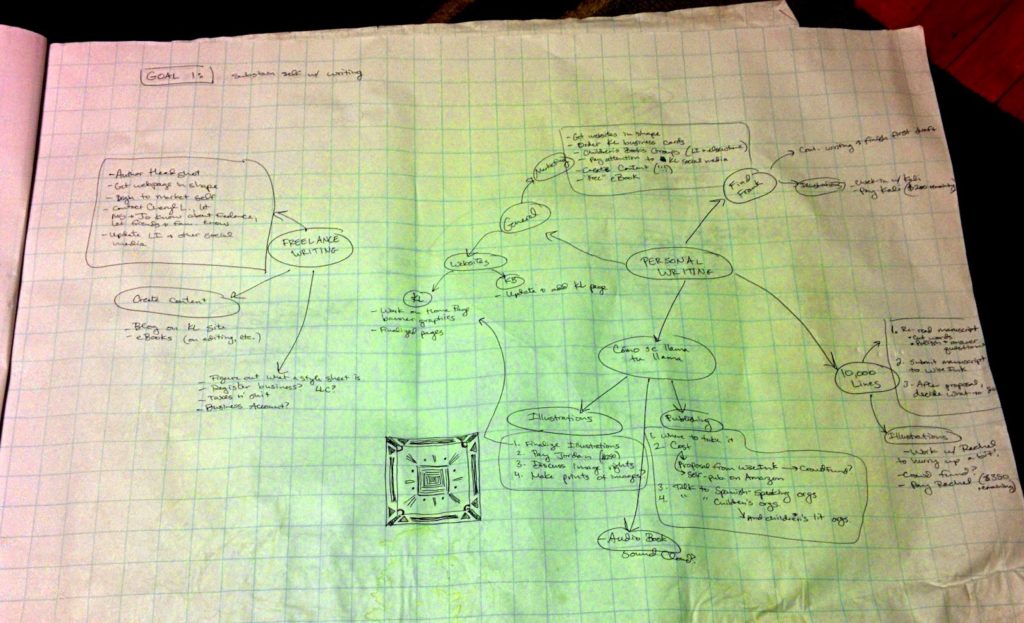You wouldn’t know it by paying attention to this particular blog (sorry–resolving to be more consistent!), but I actually write well over a hundred blog posts each year. As a ghost writer, I am the voice of several different small businesses who rely on weekly or bi-weekly content. I’ve written blog posts on topics as diverse as personal finance, creating kitchen storage solutions, and asking for a pay raise.
HOW DO I KEEP GENERATING BLOG POST IDEAS?
DOESN’T EVERYTHING START TO SOUND THE SAME AFTER A WHILE?
I’ll admit, sometimes it’s challenging to churn out ideas and turn them into blog posts, but I’ve developed a few tricks over the years. That’s how I’ve been able to write for the same career coaching business every single week for the past six years (my longest running blogging gig).
TRY OUT A FEW IDEA-GENERATION METHODS AND SEE WHAT WORKS FOR YOU. I’VE HAD SUCCESS USING THE FOLLOWING 5 METHODS:
1. Mind Mapping
If you’ve never heard of mind mapping, start HERE. Essentially, mind mapping starts with a central idea and builds off it with sub-ideas. It’s a way to let one idea lead to another, to another, to another. I use a gigantic 2’ x 3’ notepad and scribble my ideas all across the page (I also like to use my giant notepad for creating story arcs/ideas for fiction-writing).

Let’s say I’m blogging for an interior decorating company. I’ll put the company’s name in the middle of my notepad and circle it. Then, I’ll come up with blogging categories and write them around the circle, which I will then connect to the company name with lines. Each of those blogging categories also gets a circle around it, so that it looks like a bunch of tethered bubbles surrounding the middle bubble (see visual above). The blogging categories might be things like “Kitchens,” “Bathrooms,” “DIY,” “Design Tips & Tricks,” “Designer Spotlight,” “Energy Efficiency,” etc.
Under each category, I’ll then write as many blog ideas as possible. For instance, if I were generating ideas about bathroom-related blog posts, I might list topics such as “Brightening up your bathroom,” “Bathroom trends,” “Water-saving methods,” or “Kid-friendly bathrooms.”
I can even break these topics down further. If I think about “Bathroom trends,” I might create subcategories such as “Subway tiles,” “Lighting,” or “Porcelain vessel sinks.”
Once I have my ideas, I put them in a spreadsheet, organized by category. Even the so-so- ideas go in the spreadsheet under a “maybe” tab. You never know when a subpar idea might spark something brilliant.
2. Idea Notebook/Google Keep
This one is more self-explanatory than the mind mapping example. Essentially, I either carry a notebook with me and jot down blog post ideas, OR I log my ideas into my Google Keep phone app.
If you’re familiar with Evernote, Google Keep is essentially the same thing. It is a central place (accessible by phone or on your computer) where you can keep lists, links, and ideas. It’s been super helpful over the years, and when I finally broke the screen of my beloved five-year-old Nexus phone, my lists and ideas didn’t die with it. All I had to do was download the app on my new phone (which was already connected to my Google account), and BAM! All my material was still there.
However you choose to log your thoughts, make an effort to DO IT. Ideas can be slippery and you never know when one will strike…and then slither away just as quickly.
Ideas can be slippery and you never know when one will strike…and then slither away just as quickly. Click To Tweet3. Use a Spreadsheet
Zzzzzz. Boring!
Yeah, I know. Spreadsheets aren’t the most glamorous of tools, but they’re super handy. I like to track which ideas I’ve already written AND which ideas are on deck. That way, I won’t double up on a certain topic or forget to write about an entire category. I’ll also be able to see if I’m overdoing a certain category (too much kitchen talk and not enough energy efficiency!).
Spreadsheets are also a great way to track the performance of your blog posts, if you’re into the analytics side of things.
4. Recycle an Old Topic
There’s no harm in revitalizing one of your old blog posts, especially if it was written over a year ago. Chances are, not everyone saw it the first time around anyway.
If you do decide to rewrite an old blog post, add elements that make it unique from the old one (update an old news story, for example, or approach the topic from a slightly different angle). If the post is essentially the same, make a note at either the top or the bottom of the post stating:
This post was originally published on [DATE] and has been revised for [DATE].
5. Set Aside Quiet Time
This may be tip #5, but it’s a top priority in my book. My best ideas come when I’m alone with my notebook (with all notifications on silent!), on a walk with the dog, or hiking/riding my bike/in the woods. Setting aside intentional time is crucial for idea-generation. When you know you’ll have an uninterrupted stretch of time, your mind is free to let go, explore, and really dig into a topic.
Setting aside intentional time is crucial for idea-generation. When you know you’ll have an… Click To TweetWhen I run, for instance, I might think about a particular topic, and let my ideas flow with each footstep. I don’t force them. They pop up when they want to.
If I’m working on a big project (ghost writing a book, starting a new fiction project), I might set aside an entire day or half-day to ruminate and jot down ideas. I LOVE this part of the writing process. It’s completely raw and full of possibilities.
BONUS: Borrow From Others
There’s no harm in taking someone else’s idea and putting your own spin on it as long as you make sure to give the original author credit. If you’re writing a business blog, you may find inspiration from an article in Harvard Business Review or Forbes. Great! Just be sure to repurpose the article into your own and, like I said, credit your sources!
So, there you have it. Five ways to generate blog post ideas. Am I missing anything? What are some of your favorite ways to brainstorm ideas?
If you have any questions or feedback, please comment below 🙂
Author: KateBitters
Kate Bitters is a Minneapolis-based author and freelance writer. She is the author of Elmer Left, Ten Thousand Lines, and He Found Me. One of her proudest/nerdiest moments was when Neil Gaiman read one of her short stories on stage at the Fitzgerald Theater.
